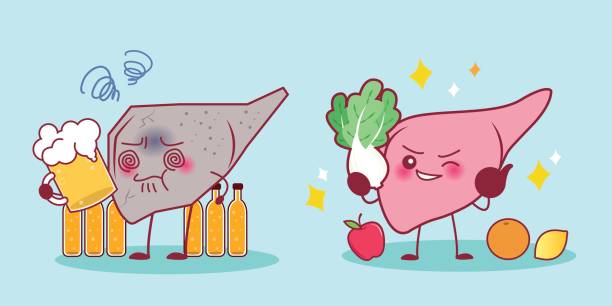General Health Tips & News
Nonalcoholic Fatty Liver Disease (NAFLD)
By A.S. (staff writer) , published on January 13, 2023

Medicine Telehealth Health NAFLD
The accumulation of excess fat in liver cells without heavy alcohol consumption as a contributing factor is known as nonalcoholic fatty liver disease (NAFLD). It is the most common form of chronic liver disease, affecting about one-quarter of the population. Alcohol-associated liver disease is the term used to describe a condition where excessive alcohol use leads to liver fat accumulation.
The liver often contains some fat. However, a fatty liver is described if more than 5% to 10% of its weight is comprised of fat (steatosis). The more severe form of NAFLD is called nonalcoholic steatohepatitis (NASH).
Nonalcoholic steatohepatitis (NASH), an aggressive form of fatty liver disease that is characterized by liver inflammation and may progress to extensive scarring (cirrhosis) and liver failure, can develop in some people with NAFLD. The harm induced by heavy alcohol usage is comparable to this harm.
High fat levels in the liver are also linked to an increased risk of significant health problems such as diabetes, high blood pressure, and renal disease. NAFLD raises your chances of getting cardiac problems if you already have diabetes.
Stages of Nonalcoholic Fatty Liver Disease
The main stages of NAFLD are:
-
simple fatty liver (steatosis) – a largely harmless build-up of fat in the liver cells that may only be diagnosed during tests carried out for another reason
-
non-alcoholic steatohepatitis (NASH) – a more serious form of NAFLD, where the liver has become inflamed
-
fibrosis – where persistent inflammation causes scar tissue around the liver and nearby blood vessels, but the liver is still able to function normally
-
cirrhosis – the most severe stage, occurring after years of inflammation, where the liver shrinks and becomes scarred and lumpy; this damage is permanent and can lead to liver failure (where your liver stops working properly) and liver cancer
Who is at risk of developing Non-Alcoholic Fatty Liver Disease?
Non-alcoholic fatty liver disease is more common in those who are overweight or obese, as well as those who have diabetes, high cholesterol, or high triglycerides. Non-alcoholic fatty liver disease can also be caused by rapid weight loss and poor eating habits.
What are the health hazards?
The liver may swell as a result of non-alcoholic fatty liver disease (steatohepatitis). An enlarged liver can develop to scarring (cirrhosis) and potentially liver cancer or liver failure over time.
What are the signs and symptoms?
Non-alcoholic fatty liver disease is frequently asymptomatic.
Fatigue, weakness, weight loss, lack of appetite, nausea, abdominal pain, spider-like blood vessels, yellowing of the skin and eyes (jaundice), itching, fluid buildup and swelling of the legs (edema) and belly (ascites), and mental confusion may occur when symptoms arise.
Diagnosis
Fatty liver disease can develop without any symptoms. It is usually diagnosed during normal blood tests to examine your liver. Non-alcoholic fatty liver disease is initially suspected if blood tests show high levels of liver enzymes.
If you have abnormal test results, your doctor may determine fatty liver disease, especially if you are obese.
Fat deposits in your liver may be shown through imaging scans. Some imaging procedures, such as specific ultrasound and MRI scans, can aid in the diagnosis of the condition and the detection of scar tissue in the liver.
-
NAFLD is diagnosed when there is fat but no inflammation or tissue damage.
-
NASH is diagnosed when there is fat, inflammation, and liver damage.
-
Cirrhosis may develop if you have fibrosis, a kind of scar tissue in your liver.
Treatment Options
There is no treatment available to reverse the fat buildup in your liver if you have NASH. In certain situations, the liver damage is stopped or reversed. In some, though, the condition progresses. Controlling any diseases that may contribute to fatty liver disease is critical if you have NASH. Eating a healthy diet and exercising regularly may help prevent liver damage from starting or reverse it in the early stages.
-
See a doctor who specializes in the liver regularly
-
Talk to your doctor about ways to improve your liver health
-
Lose weight, if you are overweight or obese
-
Lower your cholesterol and triglycerides
-
Control your diabetes
-
Avoid alcohol
References
Definition & Facts of NAFLD & NASH. (n.d.). Retrieved from National Institute of Diabetes and Digestive and Kidney Diseases (NIDDK),: https://www.niddk.nih.gov/health-information/liver-disease/nafld-nash/definition-facts
Nonalcoholic Fatty Liver Disease. (n.d.). Retrieved from Johns Hopkins Health System: https://www.hopkinsmedicine.org/health/conditions-and-diseases/nonalcoholic-fatty-liver-disease
Nonalcoholic Fatty Liver Disease (NAFLD). (2021, September 22). Retrieved from American Liver Foundation: https://liverfoundation.org/for-patients/about-the-liver/diseases-of-the-liver/non-alcoholic-fatty-liver-disease/#information-for-the-newly-diagnosed
Find articles related to: Medicine Telehealth Health NAFLD
More articles about General Health Tips & News
Back to the Health Tips Index




